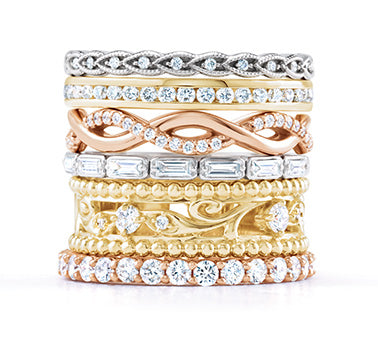Lifetime Warranty
24/7 Hour Customer Service
Free Shipping
30-Day Return
Moijey Fine Jewelry & Diamonds Blog
Diamonds: From The Beginning
Originally posted on April 5th, 2017
Updated on April 2nd, 2020
Where in the world do we start talking about diamonds? How can we begin to describe the glories of a gemstone composed of carbon?
That's right. Diamonds are composed of carbon, which develops in minerals where carbon is always present. It appears that the best way to start talking about diamonds is where and how they form deep in the earth, like this diamond encased in kimberlite, which we'll talk about momentarily.
 Diamonds, the symbol of everlasting romance, need to endure extraordinary temperatures and tremendous amounts of pressure to become the beautiful and sparkling gem we all know and love today. Between 2.5 billion to 20 million years ago, diamonds formed 90 to 120 miles beneath our feet in stable areas called cratons. Cratons are the oldest and most stable landmasses on the planet.
Diamonds, the symbol of everlasting romance, need to endure extraordinary temperatures and tremendous amounts of pressure to become the beautiful and sparkling gem we all know and love today. Between 2.5 billion to 20 million years ago, diamonds formed 90 to 120 miles beneath our feet in stable areas called cratons. Cratons are the oldest and most stable landmasses on the planet.
For the carbon to form into a diamond, the temperature range has to be between 1652°F to 2372°F, and the pressure has to be between 45 kilobars and 60 kilobars. A kilobar is a unit that scientists use to measure high pressure. So 45 to 60 kilobars is 45,000 to 60,000 times the amount of pressure on the earth's surface at sea level.
The minerals that can endure the extreme heat and force to form diamonds are called peridotite and eclogite, where carbon is always present. Peridotite is one of the oldest rocks in existence, and carbon is released from the peridotite as it melts from the earth's inner heat. The carbon's release is consistent and always present. Therefore diamonds are forming even as you read this delightful article. Peridotite is on the left and eclogite in on the right. These pictures are from the Smithsonian website.


Eclogite is younger than peridotite and occurs at shallower levels in the earth's mantle. The carbon in eclogite mostly comes from organic compounds that existed millions of years ago. The natural compounds become part of the eclogite, and the resulting carbon gets released when subduction occurs. Subduction is when two plates on the earth's crust collide, forcing one under the other. The best way to describe subduction is if you slowly (very slowly) cover your left hand with your right hand.
After crystallizing, the diamonds travel to the surface while still under incredibly high pressure and high temperatures in kimberlite and lamproite pipes at speeds over 186 miles per hour. Kimberlite and lamproite are minerals that transport the diamond crystals to the earth's surface in a few hours. After traveling through the kimberlite and lamproite pipes, the diamonds enter the earth's surface through volcanic explosions!

During that time, if the pressure decreases while the heat remains the same, the diamond will transform into graphite. Depending on the conditions, you'll either get a ring or a pencil. On the left is a piece of graphite and its atomic structure from the photo collection of our Graduate Gemologist, and on the left is the ideal atomic structure for a diamond, courtesy of the GIA website. High-quality diamond rough usually form into lovely octahedrons (double-sided pyramids).


Considering that this is an article for a Fine Jewelry Company, let's focus on the diamonds, like this lovely twisted ring.

With what a diamond has to go through in the earth to become one of the world's most adored stones, it is an ideal symbol of resilience and perseverance. These qualities are brilliant for any marriage!
Diamonds: From The Beginning
Originally posted on April 5th, 2017
Updated on April 2nd, 2020
Where in the world do we start talking about diamonds? How can we begin to describe the glories of a gemstone composed of carbon?
That's right. Diamonds are composed of carbon, which develops in minerals where carbon is always present. It appears that the best way to start talking about diamonds is where and how they form deep in the earth, like this diamond encased in kimberlite, which we'll talk about momentarily.

For the carbon to form into a diamond, the temperature range has to be between 1652°F to 2372°F, and the pressure has to be between 45 kilobars and 60 kilobars. A kilobar is a unit that scientists use to measure high pressure. So 45 to 60 kilobars is 45,000 to 60,000 times the amount of pressure on the earth's surface at sea level.
The minerals that can endure the extreme heat and force to form diamonds are called peridotite and eclogite, where carbon is always present. Peridotite is one of the oldest rocks in existence, and carbon is released from the peridotite as it melts from the earth's inner heat. The carbon's release is consistent and always present. Therefore diamonds are forming even as you read this delightful article. Peridotite is on the left and eclogite in on the right. These pictures are from the Smithsonian website.


Eclogite is younger than peridotite and occurs at shallower levels in the earth's mantle. The carbon in eclogite mostly comes from organic compounds that existed millions of years ago. The natural compounds become part of the eclogite, and the resulting carbon gets released when subduction occurs. Subduction is when two plates on the earth's crust collide, forcing one under the other. The best way to describe subduction is if you slowly (very slowly) cover your left hand with your right hand.
After crystallizing, the diamonds travel to the surface while still under incredibly high pressure and high temperatures in kimberlite and lamproite pipes at speeds over 186 miles per hour. Kimberlite and lamproite are minerals that transport the diamond crystals to the earth's surface in a few hours. After traveling through the kimberlite and lamproite pipes, the diamonds enter the earth's surface through volcanic explosions!

During that time, if the pressure decreases while the heat remains the same, the diamond will transform into graphite. Depending on the conditions, you'll either get a ring or a pencil. On the left is a piece of graphite and its atomic structure from the photo collection of our Graduate Gemologist, and on the left is the ideal atomic structure for a diamond, courtesy of the GIA website. High-quality diamond rough usually form into lovely octahedrons (double-sided pyramids).


Considering that this is an article for a Fine Jewelry Company, let's focus on the diamonds, like this lovely twisted ring.

With what a diamond has to go through in the earth to become one of the world's most adored stones, it is an ideal symbol of resilience and perseverance. These qualities are brilliant for any marriage!






